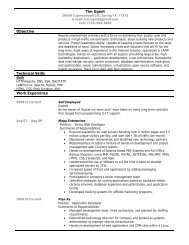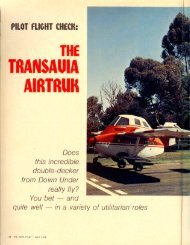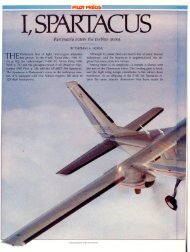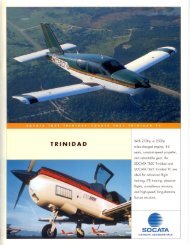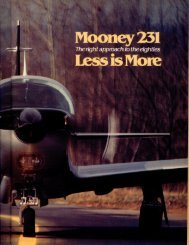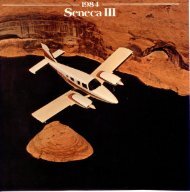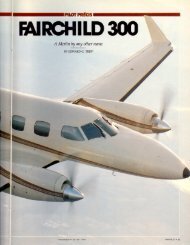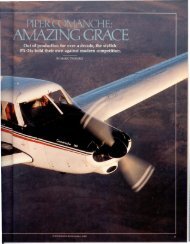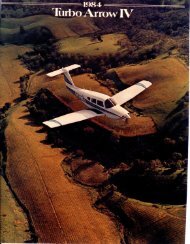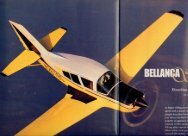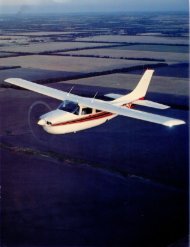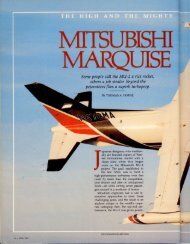Schweizer Sprite - Aero Resources Inc
Schweizer Sprite - Aero Resources Inc
Schweizer Sprite - Aero Resources Inc
Create successful ePaper yourself
Turn your PDF publications into a flip-book with our unique Google optimized e-Paper software.
continued<br />
•<br />
Soanng<br />
over drag, or LID, and is a measure of a<br />
sailplane's ability to conserve altitude<br />
as it travels horizontally. The 23:1 figure<br />
means that for every 23 feet covered<br />
horizontally, the sailplane will<br />
sink only one foot. Provided, of course,<br />
that the pilot maintains the recommended<br />
airspeed for the best LID.<br />
Strangely enough, the I-26's LID is<br />
the same as that of the heavier 2-33<br />
trainer. The 2-33's larger and longer<br />
wings make this so.<br />
As popular as the 1-26 may be, its<br />
production days are over, something<br />
that is sure to be lamented by many. In<br />
its place, the <strong>Schweizer</strong>s have come out<br />
with their latest design-the 1-36, or<br />
<strong>Sprite</strong>. The first were delivered last<br />
September, and the company is aiming<br />
for a production rate of 50 per year.<br />
"A new sailplane for a new decade,"<br />
say the brochures, but what they really<br />
mean is that the <strong>Sprite</strong> will perform<br />
better at a lower cost than any other<br />
comparable sailplane on the market.<br />
When held at 46 knots, the <strong>Sprite</strong> will<br />
achieve its best glide ratio of 31:1. This<br />
means that the pilot can range over a<br />
wider area in his search for lift, enabling<br />
him to stay longer and travel<br />
farther than he could in a 1-26.<br />
At a base price of $18,750, the<br />
<strong>Sprite</strong> is the least expensive of the<br />
<strong>Schweizer</strong> line. It is probably the least<br />
expensive new sailplane in the world,<br />
<strong>Schweizer</strong> SGS 1-36 <strong>Sprite</strong><br />
Base price $18,750<br />
Specifications<br />
Wingspan<br />
Length<br />
Height<br />
Wing area<br />
Wing loading<br />
Aspect ratio<br />
Seats<br />
Empty weight<br />
Useful load<br />
Gross weight<br />
Performance<br />
46 ft 2 in<br />
20 ft 7 in<br />
4 ft 9 in<br />
140.72 sq ft<br />
5.05 lb/sq ft<br />
15.15:1<br />
1<br />
475lb<br />
2351b<br />
7101b<br />
Best lift/drag (LID) 31:1 @ 46 kt<br />
Minimum sink 2.25 fps @ 37 kt<br />
Limiting and Recommended Airspeeds<br />
Stall speed<br />
32 KIAS<br />
Auto/winch tow speed 48 to 52 KIAS<br />
<strong>Aero</strong> tow speed<br />
52 to 61 KIAS<br />
Va (Design maneuvering) 57 KIAS<br />
Maximum spoiler open speed 105 KIAS<br />
Vne (Never exceed)<br />
105 KIAS<br />
for that matter. When enough <strong>Sprite</strong>s<br />
are sold, it is likely that they will form<br />
the basis for another one-design-class<br />
competition movement. When competition<br />
events are limited to one design,<br />
it is a pilot's soaring ability that is put<br />
on trial, not his capability to buy the<br />
fanciest high-performance sailplane.<br />
This is what put the challenge in 1-26<br />
competition soaring.<br />
A bare-bones panel is standard on<br />
the <strong>Sprite</strong>: airspeed indicator, altimeter<br />
and magnetic compass. For coordinated<br />
turns, you can order an inclinometer or<br />
install your own yawstring free of<br />
charge. Also standard is a choice of either<br />
a taildragger or a nose-skid landing<br />
gear arrangement. In the taildragger<br />
model, the landing gear (a single 5- by<br />
5-inch main wheel with hydraulic disc<br />
brake) is mounted in a forward position,<br />
and there is a small tailwheel. In<br />
the nose-skid model, the wheel is<br />
mounted farther aft, there is a skid under<br />
the nose and a smaller skid at the<br />
tail. The taildragger is recommended<br />
for an individually operated <strong>Sprite</strong>; the<br />
nose-skid model is for the rougher use<br />
that a club- or group-operated sailplane<br />
can encounter.<br />
Many options are available, enabling<br />
the owner to expand the sailplane's capabilities,<br />
even if it is at the expense of<br />
weight. There are battery and radio<br />
installations, oxygen systems and<br />
34 • AUGUST 1981


